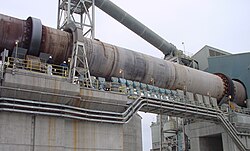Term: Cement kiln
**Cement Kiln Overview and History**:
– Cement kilns crucial for producing over a billion tonnes of cement annually.
– Process involves grinding raw materials, heating in kiln, and grinding clinker.
– Key components of Portland cement formed during the process.
– Portland cement clinker first produced in 1825.
– Traditional kilns had limitations in size and production capacity.
– Rotary kilns dominate global cement production.
– Rotary kiln is a steel tube lined with firebrick that slowly rotates.
– Rawmix fed in at the upper end and moves downhill as the kiln rotates.
– Rotary kilns have evolved in size and efficiency over time.
– Continuous kiln designs like shaft kiln and rotary kiln improved efficiency.
– The rotary kiln developed in the late 19th century revolutionized cement production.
**Kiln Processes and Equipment**:
– Wet and dry processes for preparing raw materials.
– Preheaters like grate preheaters and gas-suspension preheaters.
– Ancillary equipment includes cooler, fuel mills, fans, and exhaust gas cleaning equipment.
– Cooler types include rotary coolers, satellite coolers, and grate coolers.
– Fuel mills categories: direct firing and indirect firing.
– Fans important for moving gases in the kiln system.
– Gas cleaning methods like electrostatic precipitators and bag-filters.
**Kiln Control and Emissions**:
– Online X-ray diffraction for free calcium oxide measurement.
– Kiln operation objective: produce clinker meeting environmental standards.
– Key controls: feed rate, kiln speed, fuel injection rate, exhaust fan speed.
– Emissions measured by continuous (dust, NOx, SOx) and discontinuous methods.
– Dust emissions majorly from raw material processing, fuel preparation, clinker burning.
– Legal limits for particulate emissions reduced to 30mg/m³ today.
**Environmental Impact and Emissions Reduction**:
– CO₂ main gas emitted during clinker burning process.
– Dust emissions reduced significantly over the years.
– Nitrogen oxides formed in high-temperature clinker burning process.
– Reduction measures aim to optimize plant operation.
– Sulfur dioxide input via raw materials and fuels.
**Other Emissions and Control Measures**:
– Combustion and Selective Non-Catalytic NO Reduction.
– Carbon monoxide and total carbon emissions.
– Dioxins and furans, polychlorinated biphenyls, and polycyclic aromatic hydrocarbons.
– Rotary kilns destroy organic compounds effectively.
– Emission behavior and control measures for various pollutants.
Cement kilns are used for the pyroprocessing stage of manufacture of portland and other types of hydraulic cement, in which calcium carbonate reacts with silica-bearing minerals to form a mixture of calcium silicates. Over a billion tonnes of cement are made per year, and cement kilns are the heart of this production process: their capacity usually defines the capacity of the cement plant. As the main energy-consuming and greenhouse-gas–emitting stage of cement manufacture, improvement of kiln efficiency has been the central concern of cement manufacturing technology. Emissions from cement kilns are a major source of greenhouse gas emissions, accounting for around 2.5% of non-natural carbon emissions worldwide.

